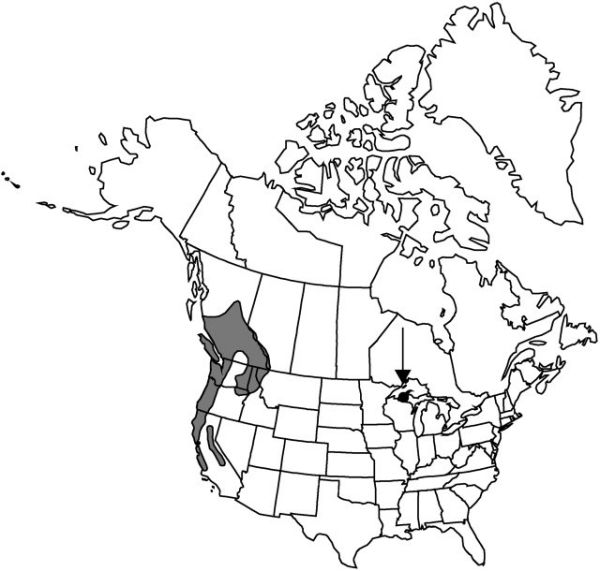Prosartes hookeri
Pacif. Railr. Rep. 4(5): 144. 1857.
Plants 3–10 dm, roughly pubescent. Stems sparingly branched. Leaves 3–9 (–14) × 1.5–5 cm; blade ovate to lanceolate, rounded to obliquely subcordate, adaxial surface glabrate or sparsely pubescent, abaxial surface scabrous or puberulent especially on veins, margins minutely pubescent to scabrous, hairs pointed sharply forward, apex long-acuminate to acute. Flowers 2–3 (–4); perianth turbinate, narrowed basally; tepals spreading, dull or creamy white to greenish white, oblanceolate, 8–18 mm, apex short-acuminate; stamens included or exserted, 8–15 mm; filaments filiform, 6–15 mm; anthers 3–5 mm, glabrous or minutely sharp-bristled; ovary ellipsoid, glabrous or somewhat pubescent, ovules 2 per locule, pendulous; styles glabrous or basal 1/2 pubescent; stigma not lobed or rarely weakly 3-lobed. Berries bright red, 4 (–6) -seeded, ovoid to obovoid, beaked with persistent style bases, 8–16 mm. Seeds 5–6 mm. 2n = 18.
Phenology: Flowering early spring–mid summer.
Habitat: Damp, shady forests and thickets
Elevation: 100–2000 m
Distribution

Alta., B.C., Calif., Idaho, Mich., Mont., Oreg., Wash.
Discussion
The three geographical races recognized as varieties by Q. Jones (1951), i.e., var. hookeri (coastal California northwards), var. oreganum (northern California north and northwestward), and var. trachyandrum (Sierra Nevada northwest to Oregon), are highly variable and intergrade with respect to their purportedly diagnostic differences in pubescence on the anthers, ovaries, and styles, and in the degree of stamen exsertion. This is especially true in their overlapping ranges in northern California and southern Oregon. Whereas the extremes may be distinctive, overall the varieties so intergrade that they are not here recognized.
From this same area, where the Coastal, Sierra, and Cascade ranges meet, the purported, sterile hybrid Prosartes parvifolia was first reported. The few older collections attributed to P. parvifolia and recent dwarf ones of P. hookeri from this area are similar, especially those from serpentine substrata, and the known variation in P. hookeri unquestionably encompasses the morphology described for P. parvifolia.
The recently discovered population of Prosartes hookeri in the Porcupine Mountains of upper Michigan (E. G. Voss 1972–1985, vol. 1) is a noteworthy disjunction for this otherwise western species.
Selected References
None.
Lower Taxa
"broad" is not a number."thicker" is not a number.